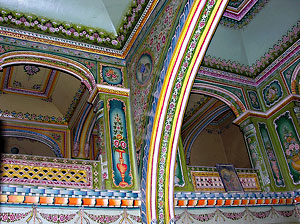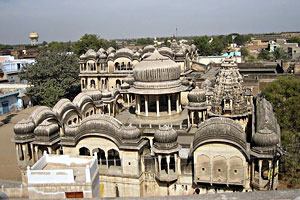|
|
|
Shekhawati Places |
|
The
tourists can stay in any of several heritage hotels in
Shekhawati that were once feudal castles. Many of these
historic hotels are beautiful examples of the painted
walls of the region. These are the true treasures of
Rajasthan’s open air art galley. Some of the major
places in Shekhawati are Mandawa, Lachhmangarh, Fatehpur,
Khatu Shyamji, Shakambari, Jhunjhunu, Sikar, Nawalgarh,
Mukundgarh, Chirawa, Dundlod and Pilani.
Mandawa |
 |
|
|
Mandawa was
founded in the 18th century and is the heart of the region of
Shekhawati. The Chokhani and Ladia havelis and the Saraf
havelis are some of the splendid havelis in Mandawa. A Shiva
temple with a rock crystal lingam is also a worth visiting
place. A medieval fort dominates the town of Mandawa. This
fort has a painted arched gateway which is adorned with Lord
Krishna and his cows. The fort is now converted into a
heritage hotel.
Lachhmangarh
One of the most imposing forts in the Shekhawati region,
Lachhmangarh commands a bird’s eye view of the town modeled to
resemble the city plan of Jaipur. Lachhmangarh was founded in
the early 19th century by Raja Lachhman Singh of Sikar. The
town of Lachhmangarh has a lot of whimsical subjects painted
on its impressive havelis.
Fatehpur
Fatehpur was founded in the mid 15th century by Fateh Khan, a
Kayamkhani nawab. The town is noted for unmatched frescoes and
exquisite havelis. It is one of the richest sources for
observing some of the finest art in the region. Its central
location has attracted many wealthy merchants. Havelis offers
a combination of the Indian and the western styles. Most
famous havelis are the Chamariya and Singhania havelis.
Khatu Shyamji
Khatu Shyamji is famous for the Shri Shyamji Temple, built in
white marble.
Shakambari
Shakambari is famous for its 7th century temple dedicated to
Shakambhari Mata. The town is surrounded by hills on three
sides. It is an ideal picnic spot.
Jhunjhunu
Jhunjhunu, the capital of Shekhawati is one of the largest
town of the district. The town was founded by the Kayamkhani
Nawabs in the mid 15th century AD and remained under their
control until it was taken over by the Rajput ruler Sardul
Singh in 1730 AD. The district town has some splendidly
painted havelis. Easily accessible of these are those of Nar
Singh Das Tibriwal, Ishwar Das-Mohan Das Modi and the Khaitans.
The most interesting monument is the Khatri Mahal (the Wind
Palace) dating back to around 1760 A.D. with elegant lines.
Rani Sati temple is the most famous temple of Jhunjhunu. The
Sri Bihariji Temple is noted for its lovely murals.
Sikar
Sikar was founded in the late 17th century. Sikar was the
largest "thikana" (Feudal state) under Jaipur. The fort and
temples of Gopinath, Raghunath and Madan Mohan with
commendable frescoes are worth visiting. The jubilee Hall,
Madho Niwas Kothi, Biwani Haveli, Sodhani Haveli, the Jain
temple and a large market are other places of interest. |
| |
|
Nawalgarh
Nawalgarh was founded in the 18th century. Nawalgarh has
the finest of Shekhawati’s frescoes. Its two old forts
and palace hotel with garden and fountains along with a
host of temples known for their architecture and
frescoes add interest to the town. The prominent havelis
are of the Poddars, Bhagats and Dangaichs.
Other Places |
 |
|
|
Mukundgarh
Mukundgarh is known for its fine havelis. The fort of
Mukundgarh is now a heritage hotel. It is a small settlement
which is easy to walk around when viewing fresco art.
Dundlod
Dundlod is known for its fort, palace and chhatri frescos. The
palace of Dundlod is now running as a heritage hotel. Havelis
of the Goenka family are also famous in Dundlod.
Churu
Though, Churu is not a part of the Shekhawati region, but it
has havelis which are mainly known for their flamboyant
architecture.
Harsh Nath Temple
Harsh Nath temple, an ancient 10th century temple is situated
on the Harsh Nath hills and is about 10 km from Shekhawati
town.
Jeen Mata Temple
Jeen Mata temple is believed to have been built a thousand
years ago. The temple is the venue of a colourful fair held
twice in a year during ‘Navaratras’.
Chirawa
Chirawa is a popular trading town between Churu and Loharu.
Chirawa is famous for huge havelis. Dalmias, Kakranias and
Nemanis Havelis and Poddar wells are worth visiting places in
Chirawa.
Pilani
Pilani is the home of the Birlas, the leading industrialists
of India. It has a large campus of the Birla Institute of
Technology and Science (BITS) which is famous all over the
world. A beautiful Saraswati Temple, BITS museum, Panchwati
and Birla Havelis are various places in Pilani.
Surajgarh and Kajara
Surajgarh has an impressive 18th century fort, painted temples
and havelis. Some beautiful 19th century havelis can be seen
in Kajara.
Alsisar and Malsisar
Alsisar was founded in the late 18th century while Malsisar
was founded in the mid 18th century. Both these towns lie at
the northern edge of Shekhawati. The angular style of frescoes
in various colours make the trip to these town a memorable
one. These two towns are distinguished by the blue and red
colour of their frescos. Beside the fort, the Jhunjhunuwala
havelis, a well complex and temples are other interesting
places in Alsisar.
Bissau
Bissau was founded in the mid 18th century. Bissau has
splendid chhatris of Thakurs and finely painted havelis of
Khemka, Tibrewals, Jhunjhunuwala and Kedia that contains high
quality of frescos. Bissau also has a fort and the Chhatri of
Hammir Singh, with paintings.
Mehansar
Mehansar was founded in the mid 18th century. The Sone-Chandi
ki Haveli and Raghunath temple with beautiful paintings of the
Bikaner School of Art are worth visiting places in Mehansar.
The finest interiors can be found here in a former jeweller’s
showroom and are rich in their use of colours and gilding. |
| |
| |
|
 |
|